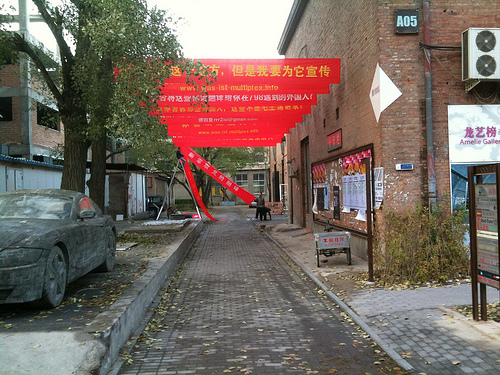Anni Art, Beijing, 8.-26.11.2009
works by 15 artists from Austria who lived in China, organized by ASAP
I am presenting a couple of new banners (other versions shown here), which were specifially adapted to the situation inside the well-known and hyped 798 art district of Beijing.


(photos by ASAP, thanks to Karel Dudesek and ASAP)
press text:
Anni Art and ASAP invite you to an exceptional exhibition of Austrian Artists and their works produced in China.
Austria is in China and China is in Austria
Fifteen Austrian artists show their works in China for the first time. This exhibition is exceptional because all works have been created by the artists during their stay in China. These works are personal explorations drafted in an individual artistic language which negotiates between the grammars of the East and the West. The exhibition offers an inside view of 15 Austrian artists: Lukas Birk, Karel Dudesek, Sylvia Eckermann, Kerstin von Gabein, Nikolaus Gansterer, G.R.A.M., Michael Hoepfner, Ulrike Johannsen, Ronald Kodritsch, Jasmin Ladenhaufen, Ralo Mayer, Matthias Meinharter, Gerald Nestler, Rainer Prohaska and Kamen Stoyanov, how their perception is inspired and translated into artistic methods, to project a different view on place, form and content. Fifteen Austrian artists lived in China, became accommodated to habits and rituals.
Fifteen artists from the other side of the world traveled east and sat down at table with the locals and tasted their food, which is so different from any Chinese restaurant food in Austria. Fifteen artists made friends and knitted relations which were supposed to last as long as possible. The artists are the first ones who live and work in the global space. Now China is in Austria and Austria is in China. We are one worl d, one nation, with different languages and rituals but similar desires. Fifteen Austrian artists with their diverse talents came to China to make use of their imagination and to interact.
They interacted with traditional painters, visited and interviewed local artists, composed songs with musicians, reflected the genderness of the media society, constructed their own vehicles to explore one of the biggest cities in the world, put up banners to manifest their irritation, worked with Chinese fashion designers and tailors to create new fashion, painted pictures, painted their faces, photographed the fast changing unknown, did research while walking trough cities and across China with their own individual methods, paid massive cab bills, visited wild markets and savoured the unknown smell of the oriental world and returned to Austria with the wish to come back to be able to continue their work in China. What they shared was one common thought: That there had not been enough time available – time actually needed to accomplish their work.

Post a Comment